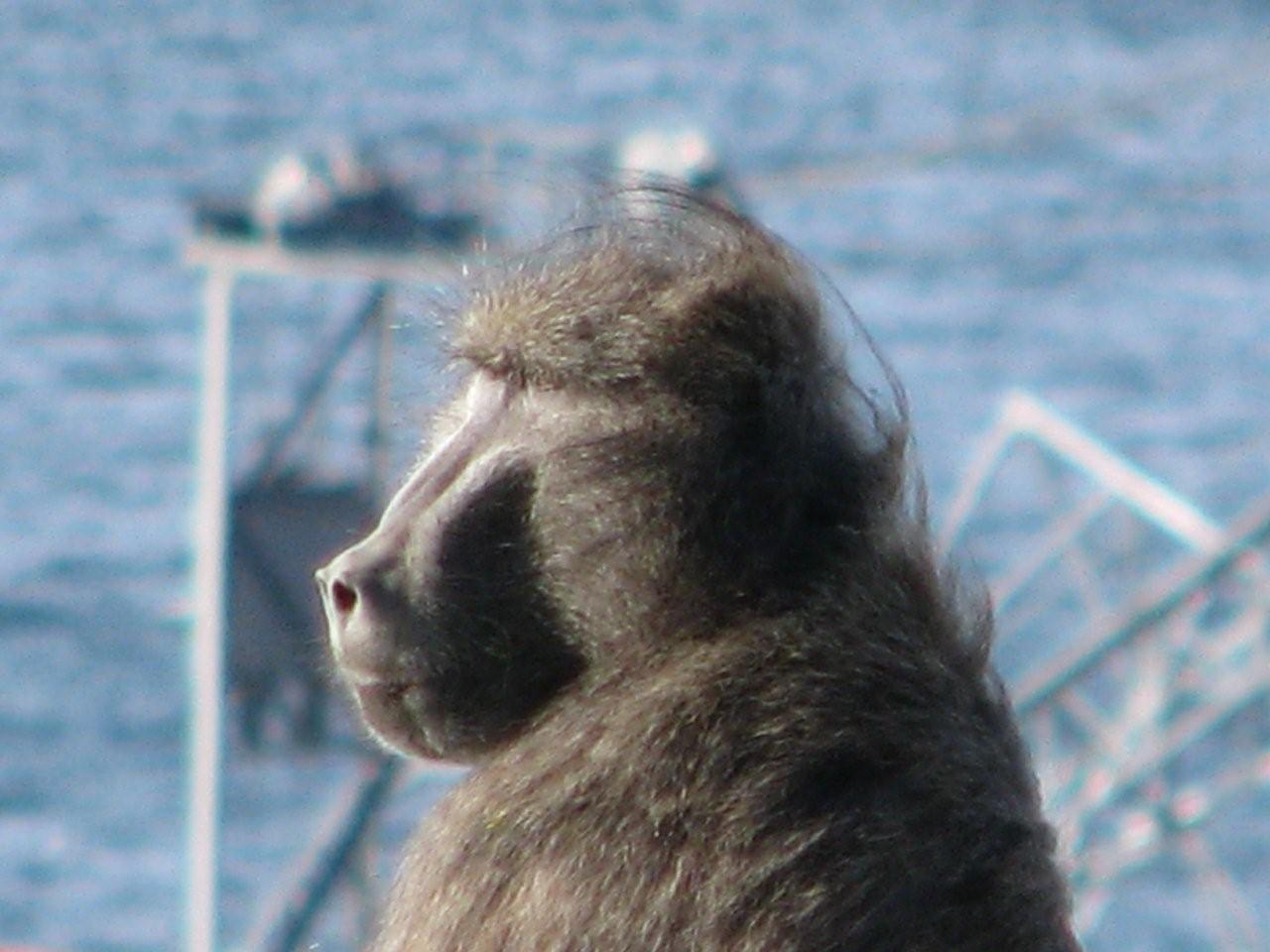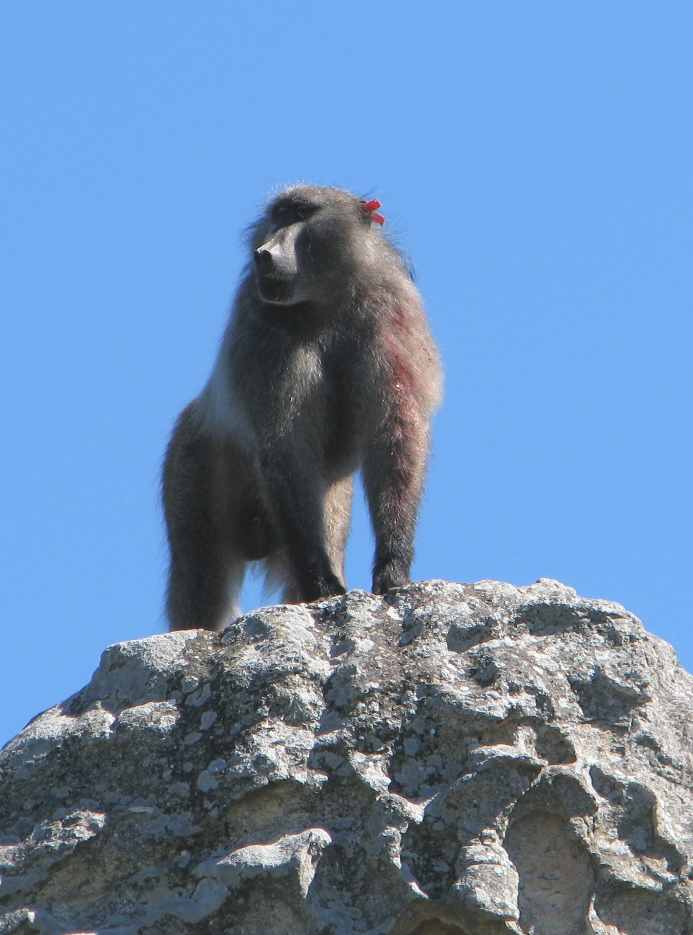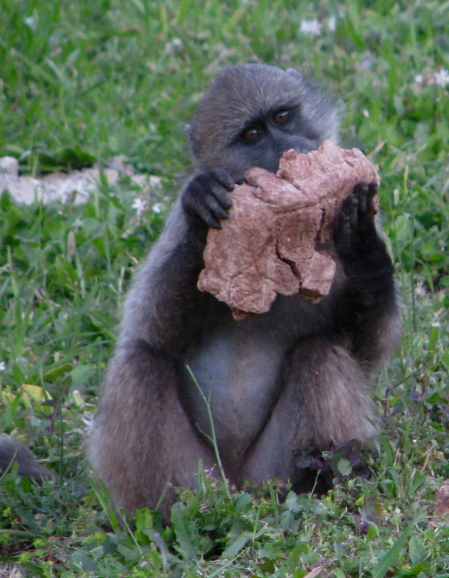THE CONTROVERSIAL CULLING PROTOCOL OF 2009
TARGETING "DISPERSING MALES AND REPEAT
RAIDERS"

Bart, the first "dispersing male" to be targeted by the new protocol in August, 2009 Described by Dr Justin O'Riain of BRU, closely involved with the preparation of the protocol, as "a fantastic animal" and "no threat to anyone", he nevertheless supported Bart's culling and that of other baboons by means of the controversial protocol regarded as biased against baboon's natural behaviour.

Anele, (pictured) a young adult male baboon. Together with Bart, Sol and other so-called "dispersing males" Anele was ear tagged in terms of the controversial protocol targeting "dispersing males and/or repeat raiders" - the initial step putting him on "death row".
While much has been made of attempts to find dispersing males new troops at the third capture, this is often simply not an option in practical terms.
It must be noted that the option also exists for killing "dispersing males and/or repeat raiders" from the 2nd to the 4th and final capture, obviously making it a culling protocol, a fact denied by BRU, the baboon research unit based at UCT.
BRU was involved in preparing the protocol in
August 2009 and is consulted by CapeNature, SANParks, the City and NCC the service provider as well as the Baboon Liaison Group of which it is a founding member. The protocol has been strongly criticized by
independent scientists and experts.
The
protocol can also be potentially used to target any of Cape
Town's ostensibly legally protected baboons
under the "repeat raider" category by defining them as problem animals.
(Provisions for "individual raiders" as well as other categories were made in a June 2010 protocol.)
Protected in the Peninsula since 1997, elsewhere in the country baboons are classified as problem animals or "vermin" or damage causing problem animals, including for raiding and killed with impunity. In effect, the protocol attempts to remove their protected status because given the opportunity any baboon will raid or eat available food.
There have been appeals to the Mayor of Cape
Town to stop the culling, revoke the protocol and for other independent
expert opinion to be heeded.
Male Chacma baboons may "disperse" or leave the troop a number of times during their lives.
They may temporarily leave their troop when
there is fighting between males for dominance to avoid further injuries
but return to it later. They may
take a female or two with them and begin their own troop - called a fission troop. They may even move on
further to
join another troop.
However, given the layout of the Peninsula and baboon home
ranges as defined by BRU, it may be very difficult for baboons to avoid coming into
an urban area, sometimes
separated by only a street. This factor becomes of particular importance when they can be culled for doing so.
Essentially
the
protocol
states that if a baboon disperses from or leaves his troop and goes
into the urban area, he can be captured and tagged, the first
step in the culling process. In terms of the protocol, if he leaves his troop again,
he is captured and released in the
same area.
On the third capture, he is given a final opportunity to integrate with a different troop in another area which is deemed by officials to have "a vacancy" for a male.
The baboon may now also be far away
from his natal troop which he could have naturally returned to of his own accord. In nature, dispersing to another troop may be a lengthy process, something the protocol attempts to unrealistically hasten by allowing one attempt at integration in a distant troop where he will most likely be seen as an intruder and fought off. Additionally baboons may disperse a number of times during their lifetime eg WIlliam started in the Da Gama Park troop, naturally dispersed to Kommetjie, then to Scarborough.
While it may be claimed the baboons are given another opportunity to make a "choice" of joining a new troop before being killed, if the odds are against them joining, this third option is not a viable option. Relocating a baboon far from its natal troop more than likely means he will again pass through urban areas. He also becomes more vulnerable when away from the protection of the troop.
According to the protocol on the 4th capture he can be captured and killed. However, the protocol also says the baboon can be killed from the second capture, which some see could be adopted as the easiest and cheapest "solution".
It is of note that the protocol also allows an
option for sanctuary on the 4th and final capture. The protocol
was officially implemented in August. BRU co-founder, Julian Saunders publically
broached the idea of a sanctuary/safari park as "the obvious solution"
in a local newspaper in October, saying it's primary objective would be education regarding the plight of baboons. (He had
broached the idea to other BRU members several years ago.)
Saunders' envisaged
sanctuary would have limited
occupancy and also concentrate on the plight of other baboons in Africa
so it cannot be seen in any way as coming to the aid of the
Peninsula free-ranging baboons, ironically, currently threatened in the first place
by the protocol.
He presented the argument of working for "the greater good" and saving the species. This is not really applicable in the case of the Peninsula baboons where it is important to save the individuals of this already endangered population, lest troops diminish to the point of being unviable.
Caring for the individual of a small "critically endangered" population includes not simply killing animals because they are coming into the urban area from time to time, especially when human responsibility can prevent raids. It also includes giving assistance to seriously injured animals.
If the view is held that the Peninsula baboons can simply be replaced with baboons from elsewhere, the approach of the individual being of secondary importance would make sense, although is far from understandable.
BRU has publically stated it regards the map of baboon
home ranges they have prepared as "the most significant contribution to
management and conservation of baboons in the Peninsula" yet ironically, the
protocol they endorse could be seen as the most significant threat to baboons in
the Peninsula. The maps were presented as a means to protect the baboon's home ranges from urban development, yet what seems more apparent is that the unit is focusing on urban areas being protected from baboons intrusion. Dr O'Riain shares the view of some residents lobbying for the total removal of baboons from urban areas.
The
protocol is
similarly biased against natural behaviour of the rest of the
baboons
- eating available food.
While some residents resent or even hate the baboons and may injure and kill them, other residents co-exist with baboons harmoniously and even enjoy their occasional visits to residential areas as a privilege of living in a more natural surrounding, also tolerant because they understand habitat has been reduced. These residents have learned to take security measures that prevent raids, consequently reducing or eliminating potential conflict - i.e. securing bins and houses by consistent, effective baboon-proofing means baboons will not raid them.
Baboons have raided in the Cape for
numerous years, attracted by food made available deliberately or negligently by residents and tourists. Their raiding behaviour was recorded at the time of Van Riebeeck's arrival in the Cape, there are newspaper reports in the 1930's and 50'sof baboon-human interaction related to food on the road to Cape Point.
There is
nothing new in that behaviour as some residents tried to make out
in 2009,
also saying baboons are "increasingly aggressive", an attempt to make
authorities take drastic action such as culling the already endangered
Peninsula baboons.
It should be pointed out that there has long been an organized
anti-baboon lobby in certain areas who want baboons totally removed from urban areas, admitting to putting pressure on authorities with fear-mongering stories of baboons' potential
threat to human safety "in the future". (It should be noted that "man's best friend" the dog, more regularly poses a threat to both human and baboon safety. While the leopard may not prey on the urban baboons, baboons are certainly injured and killed by dogs.)
The introduction of
the protocol in
August followed on some residents' public protests and meetings in
May 2009, Simonstown residents forming a group to "chase" baboons out with
bullwhips and bearbangers in June, the baboon expert workshop hosted by
the City and
CapeNature and the appointment of a new interim service provider by the
BMT amidst
allegations of a flawed process in July.
The preparation of the
protocol by BRU occurred in August, bull whips were introduced for monitoring in
September and objected to by the SPCA, the trapping of a "repeat raider" in
October after complaints by a shop-owner who like some residents
refuses to baboon-proof, but instead blames the baboons. In November Anele, one of the first baboons tagged, died when he was ridden over by a resident. BRU denied for several months that it was him. Bart was supposedly also knocked down yet no body was found. It is extremely difficult to obtain either any, or credible and
non-conflicting information about the baboons. Under the
circumstances, with culling protocols in place, this is seen as aiding transparency.
The Simonstown Civic Association, who had originally put pressure on the authorities in 2009 in a February 2010 newsletter wrote that they were in the process of forming a civic baboon oversight group {BLG} to "push for all baboons near residential areas to be actively and humanely managed (being kept out of residential areas 100% of the time). The STCA is involved in the establishment of this oversight group and will continue to put pressure on the authorities to accelerate the broadening of management to all baboon troops."
People can live for numerous years even in the same streets where there is most discontent about baboon presence because they take the right security measures. Unfortunately, others are less tolerant and cause permanent injury or death to the animals from old to young, male or female.
The "Action
plan for dispersing males and/or repeat raiders" as "prepared by BRU" in
August 2009 and subsequently endorsed and defended by them as not being a "culling protocol" despite all evidence to the contrary, is fatally flawed
and unfairly targets Cape Town's baboons, considered to be
a "major asset" of the City and a popular tourist attraction.

This shows how biased the protocol is against the baboons. The protocol attempts to remove their protected status - labelling them as repeat raiders i.e. problem animals, the status in the rest of the country where they are killed as vermin.
All Content Copyright 2009-10
All Rights reserved
No portion of content may be reproduced in any way without written permission